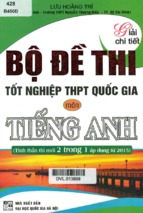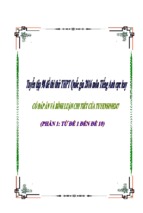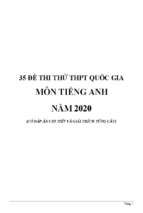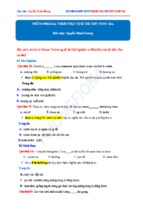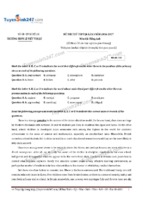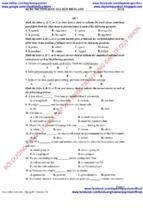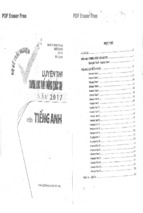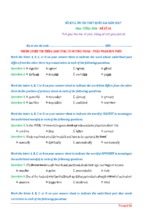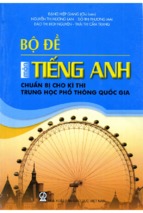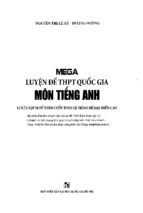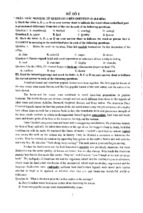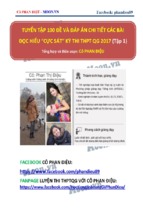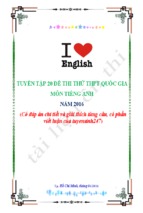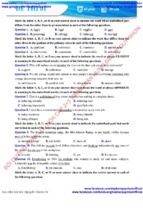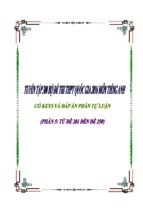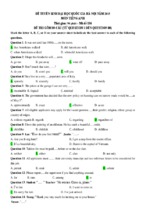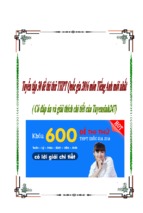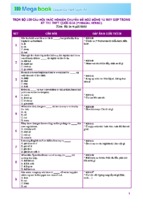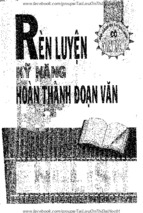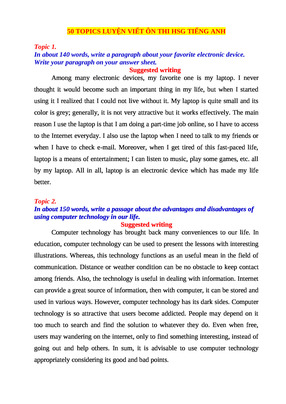ĐỀ SỐ 6
ĐỀ THI THỬ THPT QG NĂM HỌC 2020
Môn: Tiếng anh
Thời gian làm bài: 60 phút, không kể thời gian phát đề
Mark the letter A, B, C, or D on your answer sheet to indicate the word whose underlined part
differs from the other three in pronunciation in each of the following questions.
Question 1.
A. inform
B. situation
C. dialogue
D. signal
Question 2.
A. fare
B. black
C. match
D. calcium
Mark the letter A, B, C, or D on your answer sheet to indicate the word that differs from the
other three in the position of primary stress in each of the following questions.
Question 3.
A. recently
B. attitude
C. octopus
D. proposal
Question 4.
A. visible
B. solution
C. surrounding
D. arrival
Mark the letter A, B, C, or D on your answer sheet to indicate the correct answer to each of the
following questions.
Question 5. John proposed _________ Mary on a fine day at the crowded beach in their
hometown.
A. to
B. of
C. on
D. with
Question 6. Genetically, the chimpanzee is more similar to humans _________.
A. are than any other animal
B. than is any other animal
C. any other animal is
D. and any other animal is
Question 7. _________ the light rain, the match will not be cancelled unless the other team
concedes.
A. Despite
B. However
C. In spite
D. Although
Question 8. As a famous person _________ many children admire, it is important for her to act
responsibly.
A. whose
B. which
C. when
D. whom
Question 9. Governments should _________ some international laws against terrorism.
A. bring up
B. bring about
C. bring in
D. bring back
Question 10. I’m sure you’ll have no _________ the exam.
A. difficulty passing
B. difficulties to pass
C. difficulty to pass
D. difficulties of passing
Question 11. The greater the demand, _________ the price.
A. the highest
B. the high
C. higher
D. the higher
Question 12. Sometimes in a bad situation, there may still be some good things. Try not to
“throw out the _________ with the bathwater”.
A. fish
B. duck
C. baby
D. child
Question 13. __________, we tried our best to finish it.
A. Difficult as the homework was
B. Thanks to the difficult homework
C. As though the homework was difficult
D. Despite the homework was difficult
Trang 1
Question 14. When my father was young, he __________ get up early to do the gardening.
A. used to
B. was used to
C. got used to
D. use to
Question 15. Tuan painted his bedroom black. It looks dark and dreary. He __________ a
different color.
A. had to choose
B. should have chosen
C. must have chosen
D. could have
chosen
Question 16. The climate of China is similar in many ways to __________.
A. that of the United States
B. which of the United States
C. the United States
D. this of the United States
Question 17. Don’t worry! He’ll do the job as __________ as possible.
A. economical
B. economically
C. uneconomically
D. beautifully
Question 18. __________ non-verbal language __________ important aspect of interpersonal
communication
A. -/an
B. The/C. A/the
D. The/a
Mark the letter A, B, C, or D on your answer sheet to indicate the word(s) CLOSEST in meaning
to the underlined word(s) in each of the following questions.
Question 19. Emissions from factories and exhaust fumes from vehicles can have detrimental
effects on our health.
A. beneficial
B. neutral
C. needy
D. harmful
Question 20. I just want to stay at home to watch TV and take it easy.
A. sleep
B. sit down
C. eat
D. relax
Mark the letter A, B, C, or D on your answer sheet to indicate the word(s) OPPOSITE in
meaning to the underlined word(s) in each of the following questions.
Question 21. Mutualism is a type of symbiosis that occurs when two unlike organisms live
together in a state that is mutually beneficial.
A. alike
B. likely
C. similar
D. dislike
Question 22. Tom may get into hot water when driving at full speed after drinking wine.
A. get into trouble
B. stay safe
C. fall into disuse
D. keep calm
Mark the letter A, B, C, or D on your answer sheet to indicate the option that best completes each
of the following exchanges.
Question 23. Mary is talking to her professor in his office.
- Mary: “Can you tell me how to find material for my science report, professor?”
- Professor: “___________”
A. I like it that you understand.
B. Try your best, Mary.
C. You can borrow books from the library.
D. You mean the podcasts from other students?
Question 24. - Hoa: “Would you mind closing the door?”
- Hung: “______________.”
A. Yes, of course. Are you tired?
B. No, not at all. I’ll do it now
C. Yes, I do. You can close it.
D. Don’t worry. Go ahead!
Trang 2
Read the following passage and mark the letter A, B, C, or D on your answer sheet to indicate
the correct word or phrase that best fits each of the numbered blanks from 25 to 29.
Face-to-face conversation is a two-way process: You speak to me, I reply to you and so on. Twoway (25) __________ depends on having a coding system that is understood by both sender and
(26) __________ , and an agreed convention about signaling the beginning and end of the
message. In speech, the coding system is the language like English or Spanish; the convention
that one person speaks at a time may seem too obvious to mention. In fact, the signals
(27)__________ in conversation and meetings are often (28) __________ . For example,
lowering the pitch of the voice may mean the end of a sentence, a sharp intake of breath may
signal the desire to interrupt, catching the chairman’s eye may indicate the desire to speak in a
formal setting like a debate, a clenched fist may indicate anger. When (29) __________ visual
signals are not possible, more formal signals may be needed.
Question 25.
A. exchange
B. interchange
C. communication
D.
correspondence
Question 26.
A. announcer
B. receiver
C. messenger
D. transmitter
Question 27.
A. that people use
B. are used
C. using
D. being used
Question 28.
A. informal
B. non-verbal
C. verbal
D. formal
Question 29.
A. their
B. these
C. this
D. that
Read the following passage and mark the letter A, B, C, or D on your answer sheet to indicate
the correct answer to each of the questions from 30 to 34.
The first birds appeared during late Jurassic times. These birds are known from four very good
skeletons, two incomplete skeletons, and an isolated feather, all from the Solnhofen limestone of
Bavaria, Germany. This fine-grained rock, which is extensively quarried for lithographic stone,
was evidently deposited in a shallow coral lagoon of a tropical sea, and flying vertebrates
occasionally fell into the water and were buried by the fine limy mud, to be preserved with
remarkable detail. In this way, the late Jurassic bird skeletons, which have been named
Archaeopteryx, were fossilized. And not only were the bones preserved in these skeletons, but so
also were imprints of the feathers. If the indications of feathers had not been preserved in
association with Archaeopteryx, it is likely that these fossils would have been classified among
the dinosaurs, for they show numerous theropod characteristics. Archaeopteryx were animals
about the size of a crow, with an archeosaurian type of skull, a long neck, a compact body
balanced on a pair of strong hind limbs, and a long tail. The forelimbs were enlarged and
obviously functioned as wings.
Modem birds, who are the descendants of these early birds, are highly organized animals, with a
constant body temperature and a very high rate of metabolism. In addition, they are remarkable
for having evolved extraordinarily complex behavior patterns such as those of nesting and song,
and the habit among many species of making long migrations from one continent to another and
back each year.
Trang 3
Most birds also have very strong legs, which allows them to run or walk on the ground as well as
to fly in the air. Indeed, some of the waterbirds, such as ducks and geese, have the distinction of
being able to move around proficiently in the water, on land, and in the air, a range in natural
locomotor ability that has never been attained by any other vertebrate.
Question 30. According to the author, all of the following evidence relating to the first birds was
found EXCEPT __________.
A. nesting materials
B. four skeletons in good condition
C. two fragmented skeletons
D. a single feather
Question 31. It can be inferred from the passage that the Archaeopteryx were classified as birds
on the basis of__________.
A. imprints of bones
B. imprints of feathers
C. the neck structure
D. skeletons
Question 32. The word “they” in the first paragraph refers to__________.
A. indications
B. fossils
C. dinosaurs
D. characteristics
Question 33. The author mentions all of the following as examples of complex behavior patterns
evolved by birds EXCEPT__________.
A. migrating
B. nesting
C. singing
D. running
Question 34. The word “attained” in the last paragraph is closest in meaning to__________.
A. required
B. achieved
C. observed
D. merited
Read the following passage and mark the letter A, B, C, or D on your answer sheet to indicate
the correct answer to each of the questions from 35 to 42.
In the North American colonies, red ware, a simple pottery fired at low temperatures, and stone
ware, a strong, impervious grey pottery fired at high temperatures, were produced from two
different native clays. These kinds of pottery were produced to supplement imported European
pottery. When the American Revolution (1775-1783) interrupted the flow of the superior
European ware, there was incentive for American potters to replace the imports with comparable
domestic goods. Stoneware, which had been simple utilitarian kitchenware, grew increasingly
ornate throughout the nineteenth century, and in addition to the earlier scratched and drawn
designs, three-dimensional molded relief decoration became popular. Representational motifs
largely replaced the earlier abstract decorations. Birds and flowers were particularly evident, but
other subjects - lions, flags, and clipper ships - are found. Some figurines, mainly of dogs and
lions, were made in this medium. Sometimes a name, usually that of the potter, was diestamped onto a piece. As more and more large kilns were built to create the high-fired stoneware,
experiments revealed that the same clay used to produce low-fired red ware could produce a
stronger, paler pottery if fired at a hotter temperature. The result was yellow ware, used largely
for serviceable items; but a further development was Rockingham ware - one of the most
important American ceramics of the nineteenth century. (The name of the ware was probably
derived from its resemblance to English brown-glazed earthenware made in South Yorkshire.) It
was created by adding a brown glaze to the fired clay, usually giving the finished
Trang 4
product a mottled appearance. Various methods of spattering or sponging the glaze onto the ware
account for the extremely wide variations in color and add to the interest of collecting
Rockingham. An advanced form of Rockingham was flint enamel, created by dusting metallic
powders onto the Rockingham glaze to produce brilliant varicolored streaks.
Articles for nearly every household activity and ornament could be bought in Rockingham ware:
dishes and bowls, of course; also bedpans, foot warmers, cuspidors, lamp bases, doorknobs,
molds, picture frames, even curtain tiebacks. All these items are highly collectible today and are
eagerly sought. A few Rockingham specialties command particular affection among collectors
and correspondingly high prices.
Question 35. The word “ornate” in paragraph 1 is closest in meaning to ____________.
A. elaborate
B. puzzling
C. durable
D. common
Question 36. The passage suggests that the earliest stoneware ____________.
A. was decorated with simple, abstract designs
B. used three-dimensional decorations
C. was valued for its fancy decorations
D. had no decoration
Question 37. How did yellow ware achieve its distinctive color?
A. By sponging on a glaze
B. By dusting on metallic powders
C. By brown-glazing
D. By firing at a high temperature
Question 38. The phrase “derived from” in paragraph 2 is closest in meaning to ____________.
A. ruined by
B. warned against
C. based on
D. sold by
Question 39. The word “It” in paragraph 2 refers to __________.
A. red ware
B. yellow ware
C. Rockingham ware
D. English brown-glazed earthenware
Question 40. The phrase “account for” in paragraph 2 is closest in meaning to __________.
A. explain
B. restrict
C. finance
D. supplement
Question 41. What was special about flint enamel?
A. Its even metallic shine
B. Its mottled appearance
C. Its spattered effect
D. Its varicolored streaks
Question 42. Which of the following kinds of Rockingham ware were probably produced in the
greatest quantity?
A. Picture frames
B. Dishes and bowls
C. Curtain debacles
D. Doorknobs
Mark the letter A, B, C, or D on your answer sheet to indicate the underlined part that needs
correction in each of the following questions.
Question 43. (A) It is a good idea (B) to be careful in (C) buying or purchasing magazines from
salespersons (D) who may come to your door.
Question 44. The (A) better you (B) are at English, (C) more opportunities you have to get (D) a
well- paid job in this country.
Question 45. Dr. Roberts, the first woman to be (A) elected president of the university, (B) is
intelligent, capable and (C) awareness of the problem (D) to be solved.
Mark the letter A, B, C, or D on your answer sheet to indicate the sentence that is closest in
Trang 5
meaning to each of the following questions.
Question 46. Bill’s English is much better than it was.
A. Bill speaks English better now than he did before.
B. Bill has started to learn English but doesn’t speak it well
C. Bill has always spoken good English.
D. Bill’s English was much better than it is now.
Question 47. You can stay in the flat for free as long as you pay the bills.
A. Whether you pay the bills or stay in the flat, it is free.
B. Without the bills paid, you can stay in the free flat.
C. Unless the flat is free of bills, you cannot stay in it.
D. Provided you pay the bills, you can stay in the flat for free.
Question 48. Even though some events were cancelled, thousands of people attended the festival.
A. In spite some cancelled events, thousands of people attended the festival.
B. Despite the cancellation of some events, thousands of people attended the festival.
C. No matter how many people attended the festival, some events were cancelled.
D. As some events were cancelled, thousands of people attended the festival.
Mark the letter A, B, C, or D on your answer sheet to indicate the sentence that best combines
each pair of sentences in the following questions.
Question 49. She wasn’t wearing a seat-belt. She was injured.
A. If she hadn’t been wearing a seat-belt, she wouldn’t have been injured.
B. If she had been wearing a seat-belt, she would have been injured.
C. If she had been wearing a seat-belt, she wouldn’t be injured.
D. If she had been wearing a seat-belt, she wouldn’t have been injured.
Question 50. A simplified edition is easier to read than the original. It is shorter.
A. A simplified edition which is shorter than the original is easier to read.
B. A simplified edition who is shorter than the original is easier to read.
C. A simplified edition is easier to read than the original which is shorter.
D. A simplified edition is easier to read than the original that is shorter.
Đáp án
1-C 2-A 3-D 4-A 5-A 6-B 7-A 8-D 9-C 10-A
11-D 12-C 13-A 14-A 15-B 16-A 17-B 18-A 19-D 20-D
21-C 22-B 23-C 24-B 25-C 26-B 27-A 28-B 29-B 30-A
31-B 32-B 33-D 34-B 35-A 36-A 37-D 38-C 39-C 40-A
41-D 42-B 43-C 44-C 45-C 46-A 47-D 48-B 49-D 50-A
LỜI GIẢI CHI TIẾT
Question 1: Đáp án C
- inform /ɪnˈfɔːm/ (v): thông báo
- situation /ˌsɪtʃʊˈeɪʃn/ (n): tình hình, hoàn cảnh, trạng thái, tình huống
Trang 6
- dialogue /ˈdaɪəlɒɡ/ (n): cuộc đối thoại/hội thoại
- signal /ˈsɪɡnəl/ (n): dấu hiệu, tín hiệu, hiệu lệnh
Question 2: Đáp án A
- fare /feə/ (n): tiền xe, tiền vé - black /blæk/ (adj): đen; tối
- match /mætʃ/ (n): diêm; cuộc thi đấu - calcium /ˈkælsɪəm/ (n): canxi
Question 3: Đáp án D
- recently /ˈriːsntli/ (adv): gần đây
- attitude /ˈætɪtjuːd/ (n): thái độ, quan điểm
- octopus /ˈɒktəpəs/ (n): con bạch tuộc
- proposal /prəˈpəʊzl/ (n): lời đề nghị, sự cầu hôn
Question 4: Đáp án A
- visible /ˈvɪzəbl/ (adj): hữu hình, có thể nhìn thấy được
- solution /səˈluːʃn/ (n): giải pháp, cách giải quyết
- surrouding /səˈraʊndɪŋ/ (adj): bao quanh, phụ cận
- arrival /əˈraɪvl/ (n): sự đến, sự tới nơi
Question 5: Đáp án A
- Propose to sb : cầu hôn ai
Dịch: John đã cầu hôn Mary vào một ngày đẹp trời tại bãi biển đông đúc ở quê nhà của họ.
Question 6: Đáp án B
So sánh hơn: S1 + be+ short adj-er/ more + long adj + than + S2 + be
Sau “than” có thể đảo động từ “to be” lên trước chủ ngữ để nhấn mạnh
Dịch: Về mặt di truyền, tinh tinh giống với người nhiều hơn bất kì loại động vật khác.
Question 7: Đáp án A
- Despite/ In spite of + N/V-ing/the fact that: mặc dù
- However: tuy nhiên
=> However adj/adv + S + be/V: Cho dù.. .đến thế nào đi chăng nữa thì...
- Although s + V + O,...: mặc dù
Question 8: Đáp án D
- Whose: thay thế cho tính từ sở hữu trong mệnh đề quan hệ (whose + N)
- Which: thay thế cho chủ ngữ/ tân ngữ chỉ vật trong mệnh đề quan hệ
- When: thay thế cho trạng ngữ chỉ thời gian trong mệnh đề quan hệ
- Whom: thay thế cho tân ngữ chỉ người trong mệnh đề quan hệ
(As a famous person, whom many children admire...)
Trong câu này, "whom” thay thế cho “a famous person”, làm tân ngữ
Dịch: Với tư cách là một người nổi tiếng được bọn trẻ ngưỡng mộ, rất quan trọng đối với cô ấy
trong việc hành động có trách nhiệm.
Question 9: Đáp án C
- bring up (ph.v): nuôi dưỡng
- bring about (ph.v): làm xảy ra, dẫn đến
Trang 7
- bring in (ph.v): giới thiệu/ công khai luật mới nào đó
- bring back (ph.v): mang trả lại, làm nhớ lại
Dịch: Các chính phủ nên ban hành một số luật quốc tế để chống lại khủng bố.
Question 10: Đáp án A
Cấu trúc: Have (no) difficulty (in) doing st: có (không gặp) khó khăn (trong việc) làm gì
Dịch: Tôi chắc rằng bạn sẽ không gặp khó khăn gì trong việc vượt qua kì thi
Question 11: Đáp án D
Cấu trúc: The + hình thức so sánh hơn + S + V, the + hình thức so sánh hơn + S + V (so sánh
kép: càng ...càng)
+ Hình thức so sánh hơn: short adj/adv-er hoặc more + long adj/ adv
Dịch: Nhu cầu càng lớn thì giá càng cao.
Question 12: Đáp án C
- fish (n): cá - duck (n): vịt
- baby (n) : đứa bé - child (n): đứa trẻ
throw out the baby with the bathwater: vứt bỏ cái gì đó quý báu cùng với cái gì mình không thích
Dịch: Đôi khi trong những tình huống tồi tệ thì vẫn có những điều tốt đẹp. Cố gắng đừng vứt đi
những
thứ đáng giá chỉ vì những thứ ta không thích.
Question 13: Đáp án A
- Adj/Adv + as + S + V = No matter how adj/adv + s + V = However + adj/adv + S + V: cho dù...
như thế nào đi chăng nữa thì...
- thanks to sb/sth: Nhờ vào, vì
- As though/As if: như thể là: thường chỉ một điều không có thật hoặc trái với thực tế (S + V1 +
as though/as if + S + V2)....
- despite + N/ V-ing/ (the fact that S+ V): Mặc dù
Dịch: Cho dù bài tập về nhà có khó đến thế nào thì chúng tôi vẫn cố gắng hết sức để hoàn thành
nó.
Question 14: Đáp án A
- Used to V (bare-inf): đã từng làm gì
- To be/ Get used to + V-ing: quen với làm gì/ điều gì đó
Dịch: Khi bố tôi còn trẻ thì ông thường thức dậy sớm làm vườn.
Question 15: Đáp án B
- have to + V(bare-inf): phải (do hoàn cảnh bên ngoài tác động)
- should have + PP: lẽ ra phải, lẽ ra nên
- must have + PP: chắc là đã, chắc hẳn đã
- could have + Vpp: có thể, có lẽ đã
Dịch: Tuấn đã sơn phòng ngủ của anh ấy màu đen. Nó trông tối và ảm đạm. Đáng lẽ anh ấy nên
chọn một màu khác.
Question 16: Đáp án A
Trang 8
- Trong cấu trúc so sánh,“that” và “those” có thể dùng thay thế cho danh từ phía trước (“that”
thay thế cho danh từ số ít; “those” thay thế cho danh từ số nhiều)
Trong câu này, “that” thay thế cho “The climate” ở vế phía trước
Dịch: Khí hậu ở Trung Quốc có nhiều nét tương đồng so với khí hậu của Mỹ.
Question 17: Đáp án B
Trạng từ đứng sau bổ nghĩa cho động từ (loại A)
- economical (adj): tiết kiệm, kinh tế
- economically (adv): về phương diện kinh tế, về mặt kinh tế, theo cách tiết kiệm (trái nghĩa với
uneconomically)
- beautifully(adv): tốt, hay
Dịch: Đừng lo, anh ấy sẽ làm việc đó tiết kiệm nhất có thể.
Question 18: Đáp án A
- non-verbal language (n): ngôn ngữ không lời, ngôn ngữ phi ngôn từ ~ body language: ngôn ngữ
cơ thể Đây là danh từ không đếm được nên không dùng mạo từ
- aspect (n): khía cạnh, lĩnh vực (aspect là danh từ đếm được nhưng chưa xác định nên chúng ta
dùng mạo từ “an”
Question 19: Đáp án D
- beneficial (adj): có lợi - neutral (adj): trung tính, trung lập
- needy (adj): nghèo túng, nghèo đói - harmful (adj): có hại
- detrimental (adj): có hại, bất lợi cho
Dịch: Khí thải từ các nhà máy và các phương tiện đi lại có thể tác động có hại đến sức khỏe của
chúng ta.
Question 20: Đáp án D
- take it easy ~ relax: thư giãn, thoải mái - sleep (v): ngủ
- sit down (v): ngồi xuống - eat (v): ăn
Dịch: Tôi chỉ muốn ở nhà xem ti-vi và thư giãn thôi.
Question 21: Đáp án C
- unlike (adj): khác, không giống, khác với
- alike (adj): giống, tương tự (không đứng trước danh từ)
- likely (adj): có thể, thích hợp
- similar (adj): tương tự, giống (similar to sb/sth)
- dislike (v): ghét, không thích
Dịch: Hỗ sinh là một loại cộng sinh xảy ra khi hai sinh vật khác nhau sống chung với nhau trong
một nơi mà cùng có lợi cho nhau.
Question 22: Đáp án B
- get into trouble: gặp rắc rối ~ get into hot water
- stay safe: giữ an toàn
- fall into disuse: bỏ đi, không dùng đến
- keep calm: giữ bình tĩnh
Trang 9
Dịch: Tom có thể gặp rắc rối khi lái xe quá tốc độ sau khi uống rượu.
Question 23: Đáp án C
Mary đang nói chuyện với giáo sư ở văn phòng thầy ấy.
Mary: “ Thưa giáo sư, thầy có thể chỉ cho em biết cách tìm tài liệu cho bài báo cáo khoa học
không ạ?” Giáo sư: “_______________”
A. Thầy vui vì em đã hiểu.
B. Cố hết sức nhé, Mary.
C. Em có thể mượn sách từ thư viện.
D. Ý em là những bản audio từ những học sinh khác?
Question 24: Đáp án B
Hoa: “Bạn có phiền đóng cửa lại hộ mình được không?”
Hung: “______________”
A. Ừ, tất nhiên là phiền rồi. Cậu mệt à?
B. Không, không phiền gì. Tớ sẽ đóng ngay.
C. Có. Cậu có thể đóng nó lại.
D. Đừng lo lắng. Cứ tiếp tục đi!
Question 25: Đáp án C
- exchange (n): sự trao đổi
- interchange (n): sự trao đổi lẫn nhau
- communication (n): sự giao tiếp, liên lạc
- correspondence (n): sự tương xứng; quan hệ thư từ
Question 26: Đáp án B
- announcer (n): người giới thiệu chương trình (trên đài phát thanh/ truyền hình) người báo tin
- receiver (n): người nhận
- messenger (n): người đưa tin, sứ giả
- transmitter (n): người truyền, vật truyền, máy phát
Phía trước chỗ trống là “sender” (người gửi) => từ cần điền vào cũng tương xứng
“Two-way communication depends on having a coding system that is understood by both sender
and receiver” (Giao tiếp hai chiều phụ thuộc vào hệ thống mã mà cả người gửi và người nhận
đều hiểu)
Question 27: Đáp án A
Phía sau có động từ “are” => chỗ trống cần điền là mệnh đề quan hệ để bổ sung nghĩa
Question 28: Đáp án B
- informal (adj): thân mật
- formal (adj): trang trọng
- verbal (adj): bằng lời nói
- non-verbal (adj): phi ngôn từ, không bằng lời nói
“In fact, the signals that people use in conversation and meetings are often non-verbal.” (Thực ra,
dấu hiệu mà người ta dùng trong hội thoại và trong các cuộc họp thường không bằng lời nói.)
Question 29: Đáp án B
- These + N số nhiều: những ...này
Trang 10
“When these visual signals are not possible, more formal signals may be needed.” (Khi những tín
hiệu bằng giác quan này không hiệu quả thì có thể cần đến những tín hiệu trang trọng hơn.)
Question 30: Đáp án A
Theo tác giả, tất cả các bằng chứng sau liên quan đến việc phát hiện ra những loài chim đầu tiên
NGOẠI TRỪ ________________.
A. vật liệu làm tổ
B. 4 bộ xương vẫn còn nguyên vẹn
C. 2 bộ xương bị phân thành nhiều mảnh
D. một bộ lông vũ tách biệt
Dẫn chứng: “These birds are known from four very good skeletons, two incomplete skeletons,
and an isolated feather, all from the Solnhofen limestone of Bavaria, Germany.” (Những loài
chim này được biết đến nhờ 4 bộ xương còn nguyên vẹn, 2 bộ xương không hoàn chỉnh và một
bộ lông vũ tách biệt, tất cả đều được tìm thấy ở khu đá vôi Solnhofen ở bang Bavaria - Đức.
Question 31: Đáp án B
Chúng ta có thể suy ra từ bài đọc rằng Archaeopteryx (chim thủy tổ) được xếp loại thành loài
chim dựa trên ______________
A. dấu vết của xương
B. dấu vết của lông vũ
C. cấu trúc của tổ
D. bộ xương
Dẫn chứng: “And not only were the bones preserved in these skeletons, but so also were imprints
of the feathers. If the indications of feathers had not been preserved in association with
Archaeopteryx, it is likely that these fossils would have been classified among the dinosaurs, for
they show numerous theropod characteristics.” (Và không những các bộ xương được bảo quản
mà còn có dấu vết của lông vũ.
Nếu các dấu hiệu của lông vũ đã không được bảo tồn liên quan đến loài chim thủy tổ thì có khả
năng những hóa thạch này đã được xếp loại vào 1 trong số các loài khủng long, vì chúng có
nhiều đặc điểm của khủng long chân thú.)
Question 32: Đáp án B
Từ “they” trong đoạn đầu đề cập đến _____________.
A. các dấu hiệu
B. hóa thạch
C. khủng long
D. các đặc điểm
Dẫn chứng: “And not only were the bones preserved in these skeletons, but so also were imprints
of the feathers. If the indications of feathers had not been preserved in association with
Archaeopteryx, it is likely that these fossils would have been classified among the dinosaurs, for
they show numerous theropod characteristics.” (Và không những các bộ xương được bảo quản
mà còn có dấu vết của lông vũ. Nếu các dấu hiệu của lông vũ đã không được bảo tồn liên quan
đến loài chim thủy tổ thì có khả năng những hóa thạch này đã được xếp loại vào 1 trong số các
loài khủng long, vì chúng có nhiều đặc điểm của khủng long chân thú.)
Question 33: Đáp án D
Tác giả đề cập đến tất cả những cái sau là ví dụ về các kiểu hành vi phức tạp mà loài chim tiến
hóa NGOẠI TRỪ _______________.
A. di trú
B. làm tổ
C. hát
D. chạy
Trang 11
Dẫn chứng: In addition, they are remarkable for having evolved extraordinarily complex
behavior patterns such as those of nesting and song, and the habit among many species of
making long migrations from one continent to another and back each year. (Thêm vào đó, chúng
nổi bật với các kiểu hành vi phức tạp lạ thường như việc làm tổ và hót, và thói quen cùng với rất
nhiều loài khác đó là di trú từ châu lục này đến châu lục khác và trở về vào mỗi năm.)
Question 34: Đáp án B
Từ “attained” trong đoạn cuối gần nghĩa nhất với _____________.
A. yêu cầu
B. đạt được, có được
C. quan sát
D. xứng đáng, đáng
Dẫn chứng: “Indeed, some of the waterbirds, such as ducks and geese, have the distinction of
being able to move around proficiently in the water, on land, and in the air, a range in natural
locomotor ability that has never been attained by any other vertebrate. (Thật vậy, một số loài
thủy cầm như vịt và ngỗng, có khả năng đặc biệt là có thể di chuyển dễ dàng dưới nước, trên cạn
và cả trên không, một loạt khả năng tự nhiên mà bất kỳ loài thú có xương sống nào cũng không
bao giờ có được.)
Question 35: Đáp án A
Từ “omate” trong đoạn 1 gần nghĩa nhất với _____________.
A. tỉ mỉ, công phu
B. làm bối rối
C. bền
D. chung, phổ biến
Dẫn chứng: “Stoneware, which had been simple utilitarian kitchenware, grew increasingly ornate
throughout the nineteenth century, and in addition to the earlier scratched and drawn designs,
three- dimensional molded relief decoration became popular” (Đồ gốm đá mà là các đồ dùng nhà
bếp tiện dụng đơn giản, ngày càng được trang trí công phu suốt thế kỉ 19, và ngoài các thiết kế
đơn giản được đưa ra trước đó thì trang trí chạm nổi được đổ khuôn không gian ba chiều đã trở
nên phổ biến.)
Question 36: Đáp án A
Bài đọc cho thấy rằng đồ gốm đá trước đó ____________.
A. được trang trí với các thiết kế trừu tượng, đơn giản
B. sử dụng trang trí ba chiều
C. được yêu chuộng vì trang trí đẹp
D. không có trang trí
Dẫn chứng: “Stoneware, which had been simple utilitarian kitchenware, grew increasingly ornate
throughout the nineteenth century, and in addition to the earlier scratched and drawn designs,
three- dimensional molded relief decoration became popular. Representational motifs largely
replaced the earlier abstract decorations” (Đồ gốm đá, mà là các đồ dùng nhà bếp tiện dụng đơn
giản, ngày càng được trang trí công phu suốt thế kỉ 19, và ngoài các thiết kế đơn giản được đưa
ra trước đó thì trang trí chạm nổi được đổ khuôn không gian ba chiều đã trở nên phổ biến. Các
mô tip biểu tượng đã thay thế trang trí trừu tượng trước đó.)
Question 37: Đáp án D
Trang 12
Dẫn chứng: “As more and more large kilns were built to create the high-fired stoneware,
experiments revealed that the same clay used to produce low-fired red ware could produce a
stronger, paler pottery if fired at a hotter temperature. The result was yellow ware, used largely
for serviceable items.” (Khi ngày càng nhiều lò nung lớn được xây dựng để tạo ra đồ gốm nung ở
nhiệt độ cao, các thí nghiệm cho thấy rằng cùng một loại đất sét được sử dụng để tạo ra loại đồ
gốm màu đỏ có thể tạo ra một loại gốm bền có màu nhạt hơn nếu được nung ở nhiệt độ cao hơn.
Kết quả là tạo ra loại gốm màu vàng, được sử dụng chủ yếu cho các mặt hàng tiện lợi.)
Question 38: Đáp án C
- ruined by: bị phá hủy bởi - warned against: bị cảnh báo không
- based on: được căn cứ vào - sold by: được bán bởi
“The name of the ware was probably derived from its resemblance to English brown-glazed
earthenware made in South Yorkshire” (Tên của loại gốm này có lẽ bắt nguồn từ sự giống nhau
của nó với loại đất nung có men màu nâu được làm ở Nam Yorkshire)
Question 39: Đáp án C
Từ “it” trong đoạn 2 đề cập đến ______________.
Dẫn chứng: “The result was yellow ware, used largely for serviceable items; but a further
development was Rockingham ware - one of the most important American ceramics of the
nineteenth century. It was
created by adding a brown glaze to the fired clay, usually giving the finished product a mottled
appearance” (Kết quả là cho ra loại gốm có màu vàng, được sử dụng chủ yếu cho các mặt hàng
tiện lợi; nhưng sự phát triển xa hơn nữa là đồ gốm Rockingham -một trong những loại gốm sứ
Mỹ quan trọng nhất
của thế kỷ 19. Nó được tạo ra bằng cách thêm một lớp men màu nâu vào đất sét nung, thường
cho ra một sản phẩm hoàn chỉnh với vẻ bề ngoài có nhiều màu sắc)
Question 40: Đáp án A
- explain (v): giải thích - restrict (v): hạn chế
- finance (v): cấp tiền cho - supplement (v): bổ sung
Dẫn chứng: “Various methods of spattering or sponging the glaze onto the ware account for the
extremely
wide variations in color..” (Các phương pháp khác nhau về việc tráng men cho đồ gốm giải thích
cho sự biến đổi màu sắc rất lớn...)
Question 41: Đáp án D
Dẫn chứng: “An advanced form of Rockingham was flint enamel, created by dusting metallic
powders onto the Rockingham glaze to produce brilliant varicolored streaks.” (Một hình thức cao
cấp của Rockingham là men flint, được tạo ra bằng cách hút bột kim loại trên men Rockingham
để tạo ra những vệt nhiều màu sắc rực rỡ.)
Question 42: Đáp án B
Loại nào của đồ gốm Rockingham có thể được sản xuất với số lượng lớn nhất?
Trang 13
Dẫn chứng: “Articles for nearly every household activity and ornament could be bought in
Rockingham ware: dishes and bowls, of course; also bedpans, foot warmers, cuspidors, lamp
bases, doorknobs, molds,
picture frames, even curtain tiebacks.” (=> khả năng là bát đĩa được làm với số lượng lớn nhất)
Question 43: Đáp án C
- buy (v): mua ~ purchase
Dịch nghĩa: Đó là một ý kiến hay khi cẩn thận trong việc mua các tạp chí từ người bán hàng,
những người mà có thể đến cửa nhà của bạn.
Question 44: Đáp án C
Cấu trúc: The + hình thức so sánh hơn của tính từ/trạng từ + S + V. the + hình thức so sánh hơn
của tính từ/trạng từ + S + V (so sánh kép: càng .. .càng)
The more English vocabulary we know, the better we speak. (Càng biết nhiều từ vựng tiếng Anh,
ta càng nói tốt hơn.)
more opportunities → the more opportunities
Question 45: Đáp án C
- Cấu trúc song song trong câu nghĩa là những thông tin liệt kê trong cùng một câu phải giống
nhau về từ loại hoặc thì khi thời gian trong các mệnh đề của câu là như nhau. (N-N; adj- adj;
verb-verb;...)
Dễ nhận thấy trong câu “Dr. Roberts, the first woman to be elected president of the university, is
intelligent, capable and awareness of the problem to be solved.” CÓ intelligent (adj), capable
(adj) nên awareness phải là aware (adj)
Question 46: Đáp án A
Câu ban đầu: Tiếng Anh của Bill giờ đã tốt hơn trước rất nhiều rồi.
B, C, D sai nghĩa
B: Bill đã bắt đầu học tiếng Anh nhưng nói chưa tốt.
C: Bill luôn nói tiếng anh tốt.
D: Tiếng Anh của Bill ngày trước tốt hơn bây giờ (ngược nghĩa)
Dịch: Bây giờ Bill nói tiếng Anh tốt hơn trước đây.
Question 47: Đáp án D
Câu ban đầu: “Bạn có thể ở trong căn hộ này thoải mái miễn là bạn trả hết hóa đơn.”
- Whether ...or: Liệu có ...hay không
- Without + N: Nếu không có, thiếu
- Unless ~ If ...not: Nếu ...không, trừ khi
- Provided: Miễn là, nếu
A, B,
C. sai nghĩa so với câu ban đầu
Dịch: Miễn là bạn trả hết hóa đơn thì bạn có thể ở trong căn hộ này thoải mái.
Question 48: Đáp án B
Câu ban đầu: Mặc dù một vài sự kiện đã bị hủy nhưng hàng ngàn người vẫn đã tham gia lễ hội.
A. sai cấu trúc (in spite of + N = despite)
Trang 14
C, D sai nghĩa
Question 49: Đáp án D
“Cô ấy đã không thắt dây an toàn. Cô ấy đã bị thương.”
Đây là sự việc đã xảy ra trong quá khứ => dùng câu điều kiện loại 3 để diễn tả sự việc trái với
thực tế trong quá khứ
A,
B. không hợp nghĩa
A. Nếu cô ấy đã không thắt dây an toàn thì đã không bị thương.
B. Nếu cô ấy đã thắt dây an toàn thì đã bị thương,
C. sai cấu trúc câu điều kiện loại 3
Dịch: Nếu cô ấy thắt dây an toàn, thì đã không bị thương.
Question 50: Đáp án A
“Một bản sao được làm đơn giản lại thì dễ đọc hơn so với bản gốc. Nó thì ngắn hơn.”
- which: là đại từ quan hệ chỉ vật, làm chức năng chủ ngữ hoặc tân ngữ trong MĐQH
C, D sai nghĩa so với câu ban đầu (Một bản sao được làm đơn giản lại thì dễ đọc hơn so với bản
gốc, cái mà ngắn hơn.). Ý nói bản gốc ngắn hơn (sai nghĩa với câu đề)
B sai vì dùng sai đại từ quan hệ (who là đại từ quan hệ dùng cho người)
Trang 15
- Xem thêm -

